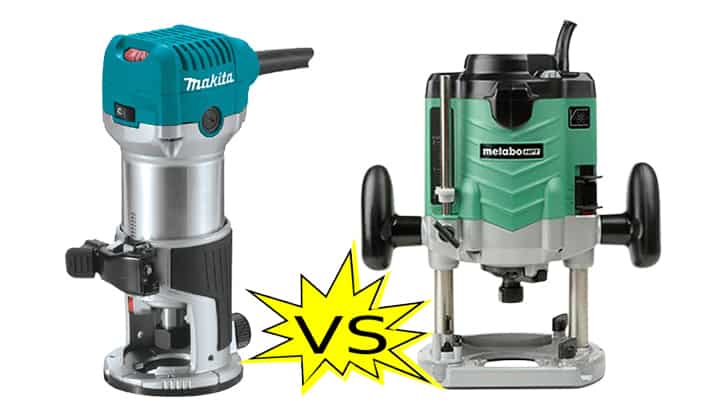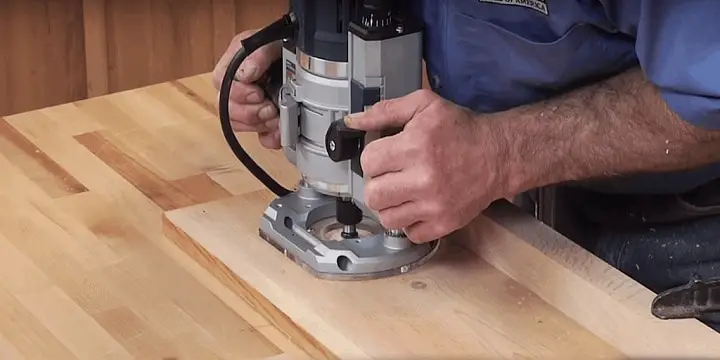I love creating free content full of tips for my readers, you. I don't accept paid sponsorships, my opinion is my own, but if you find my recommendations helpful and you end up buying something you like through one of my links, I could earn a commission at no extra cost to you. Learn more
Routers are one of the most versatile and commonly utilized trimming machines on the market today. Most commonly, they are used for trimming wood, plywood, hardboard, and metallic materials. They’re also useful for smoothing down wooden, metallic, or plastic surfaces, trimming rabbits, laminate, cleaning hardwood, lipping, drilling holes, and a variety of other tasks.

In this post we'll cover:
What Is A Trim Router
Trim routers are a smaller, more portable variant of full-sized routers. It is also known as the laminate trimmer among crafters. It originally appeared on the scene in 1998, over two decades ago, and was created specifically to cut composite countertop material. Nowadays this tiny pack router has won the hearts of craftsmen and earned a position in every crafter’s toolbox because of its durability and wide application. According to the crafter, one of the major advantages of a trim router is its compact size. Its tiny size makes it ideal for dealing with small parts. You can hold the trimmer router in one hand while steadying the workpiece with the other.Features Of A Trim Router
A trim router usually consists of an electric motor, a rotor blade, and a pilot bearing system. The trimmer’s outside casing is constructed of metal, plastic, and rubber, and it protects all of the essential components. All the trim routers have round or square bases that provide adaptability and simplicity to the equipment. It also includes a wheel lock that will help you to replace the bit easier and a quick access micro-adjustment lever for accurate depth adjustment. It also has the following features:- Material: Made of metal, plastic, and rubber.
- Trim router dimensions are approximately 6.5 x 3 x 3 inches in size.
- Product Weight: This router is extremely light. It weighs around 4 pounds.
- It has a quick-release lever that will help you to remove the motor from the base easily.
- Load Speeds: Its load speed ranges between 20,000 and 30,000 r/min (round per minute).
- Power Source: Trim router is not portable. It is powered by a power cord that connects to the main power grid.
Advantage And Disadvantages Of Trim Router
Like every other device, a trim router has some benefits and drawbacks. We’ll talk about them in this section of the text so you can decide whether a trim router is right for you.Advantages Of Trim Router
- You can use a trim router one-handedly. If you intend to use your router with a one-handed trimmer, it will be best for you.
- The size of the trim router is compact. This tiny size makes it an extremely useful tool.
- With a trim router, you can create perfect hinges around the borders of your wooden block.
- The most significant advantage of using a trim router is that it can decorate and design wooden and plastic surfaces without scratching.
- You can create a straightedge guide and butterfly patches on the surface of your workpiece using a trim router, that you can not do with a fixed or any other router.
Disadvantages Of Trim Router
- Because the trim router is not portable and is powered by a power cable from the main grid, you must operate within a certain range of the power socket.
What Is A Plunge Router
A plunge router is the developed version of the trim routers. They are larger and have more features than trim routers, such as greater power output, more efficiency, and greater adaptability on the bits, as well as the ability to regulate depth.
Features Of Plunge Router
The plunge router is made of aluminum, plastic, and rubber. This aluminum structure makes it one of the most long-lasting wood routers ever made. It includes two hardwood grips on the frame structure and a soft grip rubber handle on a plunging base, allowing for maximum user control. It has continuous response technology, which means the router will keep its speed constant throughout the operation. As a result, you will get a cleaner and more precise product. It also has certain distinguishing characteristics, like:- Material: Made of aluminum, plastic, and rubber.
- Components: Consists of a motor, a rotor blade, two arms, and a controlling lever.
- Product Dimensions: Its dimensions are approximately 6 x 11.5 x 11.6 inches in size.
- Item Weight: It’s a heavy-duty wood trimming router. Its weight is about 18.2 pounds.
- Body Thickness: The thickness of the body is around 11 inches.
Advantage And Disadvantages Of Plunge Router
Whether you’re a pro or a novice, having a plunge router in your workstation will be advantageous for you. Here are some of the most important advantages and disadvantages of using a plunge router.Advantages Of Plunge Router
- It’s a heavy-duty, industrial-grade machine that can provide you with reliable and long-term service.
- Because the plunge router has a greater RPM rate, entry will be smooth.
- A plunge router is an ideal trimmer for making inlay patterns or grooves with fine depth control.
- The plunge router works very well on the hardwood.
- One of the most significant advantages of a plunge router is its micro-adjustable control mechanism, which allows you to choose a depth while routing or fine-tuning a channel.
Disadvantages Of Plunge Router
- Because it is heavy equipment, its operation is a little more difficult and requires a lot more expertise.
- As it is a heavy-duty machine it consumes a larger amount of electricity than a trim router.
- When using a plunge router, be cautious and don’t try to use it one-handedly like a trim router. This can cause serious damage to your workpiece and, in certain cases, even injury to you.
Frequently Asked Questions (FAQ)
Q: What is the purpose of a trim router? Answer: In most workplaces, a trim router has become an important power tool nowadays. They can be used for hinge creation, rounding over corners, smooth cutting wood trimming, routing for inlay cavities, and several other jobs. Q: Is it worthwhile to invest in a trim router? Answer: Yes, of course, buying a trim router is worth it. Because it may be used for a variety of tasks, such as trimming laminate, plywood side banding, and solid-wood trimming. Q: Can I use my trim router on a router table? Answer: Yes you can. But do not require a table for trim routers because they are handy and lightweight. Even sometimes you can use them one-handedly. Q: What is the maximum depth that a plunge router can cut? Answer: The cutting depth of plunge routers varies by type and can range from 2 to 3.5 inches.Conclusion
Trim routers and plunge routers, even though only machines, have become an integral part of crafters’ lives. And you know it better than anybody if you’re a craftsman. In this post, I compared trim router vs plunge router, as well as provide you with all you need to know about their features, benefits, and drawbacks. If you’re still confused about which router is ideal for you, I recommend the trim router if you’re a beginner or want to work on a smaller project like house renovation or jewelry making. However, if you are working on a large job and need something more powerful, I strongly advise you to get a plunge router. And if you still have questions regarding trim router vs plunge router, please read the entire article thoroughly again; it will help you choose the right trimmer for your job.I'm Joost Nusselder, the founder of Tools Doctor, content marketer, and dad. I love trying out new equipment, and together with my team I've been creating in-depth blog articles since 2016 to help loyal readers with tools & crafting tips.
